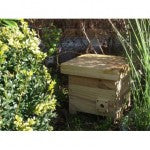If your garden is lacking buzz, there are things you can do to revive pollinators, writes Steve Wratten.
Have you seen very many bees in your garden so far this spring? Well, I haven’t. Our rosemary has been in flower more or less all winter but there have never been more than a few forlorn honey bees on it. As for bumble bees, there have been some bumbling queens buzzing around in the occasional warm spring sunshine but I can’t say I’ve seen more than half a dozen. These potential founders of new nests have been dormant for most of the winter, hibernating and emerging briefly now and again, bleary-eyed in the weak winter sun. . So, where are all our bees compared with what seem to have been good numbers only a few years ago? Worldwide, everyone is recording declines in the numbers of our vital pollinators. Estimates vary but it is generally believed that two-thirds of our food plants depend on insect pollination. If we lost the bees and their allies, we’d have to survive on bread, pasta, polenta, rice, barley and . . . wine. The first lot are made from wind-pollinated plants in the grass family and vines are wind pollinated too. ‘‘Bread and wine’’ sounds like a rural or even Biblical staple, but we’d soon suffer from malnutrition if that’s all we had.
So, what can we gardeners do? For a start, by remembering what bees need – food, a home and a life without poisons. It’s the same for us, really, though I would add gardening, cricket, birding, the arts and many more things.
Now, for a pollinator in your garden or on a farm, times can be tough.
So, where are all our bees compared with what seem to have been good numbers only a few years ago? Worldwide, everyone is recording declines in the numbers of our vital pollinators. Estimates vary but it is generally believed that two-thirds of our food plants depend on insect pollination. If we lost the bees and their allies, we’d have to survive on bread, pasta, polenta, rice, barley and . . . wine. The first lot are made from wind-pollinated plants in the grass family and vines are wind pollinated too. ‘‘Bread and wine’’ sounds like a rural or even Biblical staple, but we’d soon suffer from malnutrition if that’s all we had.
So, what can we gardeners do? For a start, by remembering what bees need – food, a home and a life without poisons. It’s the same for us, really, though I would add gardening, cricket, birding, the arts and many more things.
Now, for a pollinator in your garden or on a farm, times can be tough.
Bee-keepers provide honey-bee hives while a bumblebee nest box will offer a palace to a queen bumblebee.
As for the pollen and nectar, I don’t think I have ever seen a meadow in New Zealand – a flower-rich pasture, in other words. Pollen and nectar can be hard to come by, not just on farms but in some of our gardens too. Concrete patios and neatlytrimmed lawns are not much good.
And the poisons? Recent work in Europe has targeted a particularly toxic insecticide group – the neonicotinoids. They are based on nicotine, which the chemists have made stronger. They get into plant nectar and traces stick on bees’ knees and other parts. If these poisoned insects don’t die, they lose their way home and their nests founder and die out.
So, what to do? Lincoln’s BioProtection Research Centre have teamed up with bug man Ruud Kleinpaste and Kings Seeds to produce a flowery seed mix that makes bees think it’s their birthday. As a start, farmers markets around Christchurch have agreed to sell the mix. or you can buy our designer mix from Kings or look at their website in November for a ladybird give-away as well, in partnership with Bioforce, which breeds them. Yes, ladybirds need flowers too, as do hoverflies, lacewings, parastitic wasps, butterflies and virtually all the garden’s good guys. Don’t be put off by the global
pollinator problem; give them a home, feed them and don’t knock ‘em about with those nasty ‘‘neonics’’. See bioprotection.org.nz and creativewoodcraft.co.nz if you would like to make – or buy – a nesting box. Steve Wratten is Professor of Ecology at Lincoln University.
